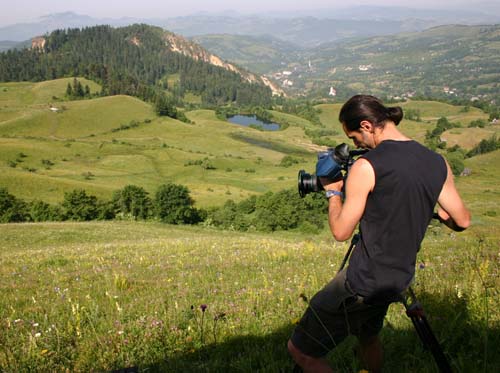From start to finish, how long did it take you to make the film?
From 2000 to 2004, the work of 5 years and over 100 colleagues helped making the film.
Was it difficult to win the trust of the villagers and convince them to participate in the film?
The people of Rosia Montana were at first mistrustful. It took a year and a half before they opened up to me, the film director. Of course my irreplaceable colleague Emoke Konecsny was a big help in this, since she speaks perfect Romanian; her family moved back to Hungary 17 years ago from Transylvania, Romania.
What kind of access did you have to the mining company?
Over the years many TV and newspaper reporters visited the location and reported on the project. Quite a few programs were made. I was just one of the many. Communication with the company wasn’t a problem. They were helpful.
The cyanide spill on the Tisza River in 2000 showed how neighboring countries are interdependent when it comes to the environment. Is that one of the central messages of your film?
Just imagine if the lakes in Canada, Lake Ontario for instance, were to be polluted, but the effects would be more severe in the US. The neighboring countries of central Europe rely on each other even more. Hungary has 8 neighbors. Furthermore it lies in the bottom of the Carpathian Basin, so all rivers run into Hungary. If the water is polluted in any of the other countries, we’re the recipients. But preserving central Europe’s natural treasures is even more important. Some of these treasures in Hungary, Slovakia and Romania cannot be found anywhere else in the world. The lack of industrial development helped preserve them. What would an Australian say if a Hungarian industrial plant of some kind had an accident in the Great Barrier Reef? He or she wouldn’t be happy about it. I made this film because I want many people to think about this.
You have described your first days of filming “Gold Futures” as analogous to ‘a filmmaker in a war zone.” Tell us what you mean.
The river Tisza runs through eastern Hungary’s dry Alföld. For the people there the river means life. When the cyanide coming from Romania destroyed most of the natural life, the people felt as if they had been rid of their element of life. Watching the villagers cleaning up the dead fish on the frozen river was like seeing them collecting the corpses of their beloved ones after a military defeat. I don’t know how to describe the sadness, the exasperation, the hopelessness.
This is why I felt like a war correspondent.
Some of your own childhood memories are connected to eastern Hungary where the Tisza River runs. Did this personal connection play a role in getting you interested in this story?
My mother has 9 siblings who live in the Alföld and the family is large. I still have 35 cousins living in that area. As a child I spent every summer at the Tisza. This did indeed strengthen my motivation to make this film. The people there are close to my heart.
What surprised you the most during the making of the film?
I’ve filmed a lot previously in Romania and Transylvania. It’s a wonderful country, but I would never have thought the mountains in Rosia Montana – just 150 km from Hungary — could hide such treasures. The landscape, the people and the Romanian mine all mean a lot to me. In the last 5 years I spent more time in Rosia Montana than in my own hometown, Pápa.

